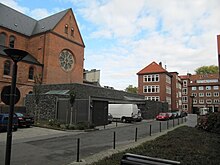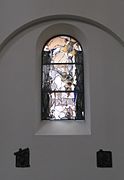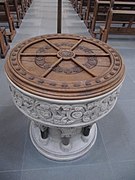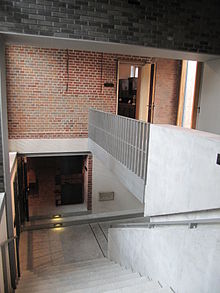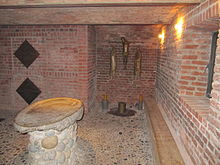St. Mary's Cathedral (Hamburg)
The St. Marien Dom (proper spelling: St. Marien Dom, colloquially Mariendom ) is the cathedral church of the Roman Catholic Archdiocese of Hamburg . The neo-Romanesque building, completed in 1893, is located in the Hamburg district of St. Georg on the Am Mariendom square , previously named Danziger Strasse , which was named in January 2013 . On the occasion of the re-establishment of the Archdiocese of Hamburg after 1,100 years on January 7, 1995, St. Marien was elevated to the status of a cathedral . In 2009 the cathedral was entered on the Hamburg-Mitte list of monuments.
history
Previous construction
St. Mary's Cathedral, which was built until 1893, is the successor to the Hamburg Cathedral of St. Mary, which was built in the old town until 1248 . This was a co- cathedral of the Bremen diocese until the Reformation was introduced in 1529 and was finally canceled between 1804 and 1807.
New building from 1889 to 1893
The church in its current form was built from 1889 to 1893 as the Roman Catholic parish church of the city of Hamburg according to plans by the Paderborn church builder Arnold Güldenpfennig in the neo-Romanesque style. The design of the double-towered west facade is based on the Bremen Cathedral .
It is the first new Catholic church in Hamburg since the Reformation in the city and the second Catholic church after St. Ansgar . Due to the Hamburg church ordinance drawn up by Johannes Bugenhagen in 1529 , public Catholic masses were forbidden until 1807. The new building could not be carried out in the old Hamburg city area, but in front of the walls of the old town in the St. Georg district. It was consecrated on June 28, 1893 by Bishop Bernhard Höting from Osnabrück and, like the Old Mariendom, which was demolished at the beginning of the 19th century, is consecrated to Mary, the Mother of God. For reasons of cost, the church was not yet painted at the inauguration.
Second World War
During the Second World War , especially during the Allied bombing raids , all the windows, including the five choir windows with images of the life of Mary , as well as parts of the roof and the vaults were destroyed.
Episcopal Church
After the Second World War , St. Marien gradually developed into lively parish life, which ultimately led to the Auxiliary Bishop of Osnabrück, Johannes von Rudloff , taking his permanent seat in Hamburg in December 1957. The Marienkirche thus became an episcopal church again, although the bishops residing here had no diocesan powers. His successor Karl-August Siegel was auxiliary bishop in Osnabrück for the regions of Bremen and Lower Saxony from 1975 and episcopal vicar for Hamburg and Schleswig-Holstein from 1978. The Archdiocese of Hamburg was rebuilt by Pope John Paul II with effect from January 7, 1995. The first diocesan bishop of the newly founded diocese was the previous Bishop of Osnabrück , Ludwig Averkamp .
Renovation and modernization 2007 to 2008
From July 2007 onwards, the church was redesigned under the direction of the architecture firm Ewers Dörnen und Partner (Oldenburg / Holstein and Hamburg). The new furnishings of the chancel ( principles and sediments ) were carried out by the Cologne artist W. Gies . In addition, a cathedral sacristy was added to meet the requirements of a cathedral church. With the solemn consecration of the altar on November 23, 2008, it was reopened as the New Mariendom (St. Marien Cathedral Hamburg). The construction costs of around 7.8 million euros were raised through donations. With the modernizations, the church became even more of the visible center of the Catholics in northern Germany.
The main changes are the artistic design of the altar island with ambo and choir stalls, extension of an atrium with cathedral cemetery, sacristy and functional rooms, redesign of the entrance areas with new portals in both towers and a transverse axis from the new side portal to the atrium, natural stone floor, renovation of the artistic glazing, complete renovation and extension of the organ, restoration of the pews, renewal of the plaster and interior painting as well as the creation of new technical systems (heating, electrics, lighting, acoustics). A new crypt was built under the church . Parts of the painting from the 1920s were exposed again.
The cathedral
architecture
St. Mary's Cathedral is a neo-Romanesque three-aisled galleries basilica of brick with transept , choir and round apse in northeast exposure . The floor plan is cross-shaped in the bound system . The prestigious portal front with the two tall, pointed towers is richly structured with double windows, arched friezes and pilaster strips and has a rose window in the middle .
The interior, completely white except for the apse and transepts, shows classic proportions. The triforias are expanded to form galleries . Its arcade arches are supported by natural stone columns with cube capitals . The cornice above the gallery connects the nave with the apse. The central nave is illuminated through high cliff windows. The arcade arches of the nave are repeated as blind arcades in the apse.
Furnishing
Wall paintings and mosaic in the apse
In 1922/23 Eduard Goldkuhle created The Coronation of Mary in the apse on a gold background , which was replaced in 1948 by a neo-Byzantine mosaic from the Mayer'schen Hofkunstanstalt in Munich in a replica of the apse mosaic of the same name by Jacopo Torriti in the papal basilica of Santa Maria Maggiore in Rome. The Latin inscription reads Assumpta est Maria in coelum (" Mary is taken up into heaven "). It was planned to install the mosaic in 1943 on the occasion of the 50th anniversary of the cathedral. The equipment had to be suspended because of the bombing.
In the area of the altar, Goldkuhle painted four large wall paintings in Nazarene style in 1927 , the Annunciation (left apse wall) and the Nativity of Christ (right apse wall), the Flight to Egypt (left transept) and the Descent from the Cross (right transept). These were painted over in the mid-1960s as a result of the liturgical reform and exposed again during the cathedral renovation in 2008.
Church window
The choir windows, which were destroyed in the Second World War, were replaced by the stained glass windows of medieval cathedrals. The modern stained glazing of the lower aisle windows is a cycle of ten arched windows (240 by 115 cm) and one round window (diameter 11 cm) by the artist Johannes Schreiter . They depict scenes from the life of the prophet Isaiah .
Altar cross
The cross, which was donated for the 100th anniversary of the church, comes from the sculptor Heinrich Gerhard Bücker and was made from 4000 year old bog oak . The front shows the crucified Jesus Christ, the back the Lamb of God.
tabernacle
The tabernacle was designed in 1964 by the Duisburg goldsmith Claus Pohl. The relief is designed as a tree of life on the front and a burning bush on the back. Initially, the tabernacle stood on a stele in the southern front yoke and was later given a large bronze attachment. After the renovation and the removal of the bronze attachment, it was given a new stele and found a new place in the northern front yoke.
Baptismal font
The massive neo-Romanesque font, which has been in the center of the cathedral since the cathedral was renovated in 2008, is attributed to the Osnabrück sculptor Heinrich Selig (1843–1912). It rests on a base that is decorated with neo-Romanesque arches and columns and on the edge of the pool with tendril and leaf ornaments.
photos
The St. Ansgar picture is a 2004 copy of the late Gothic original by Hans Bornemann , which from 1457 initially hung in the Old Mariendom , which was demolished in 1805. In 1668, the original underwent a baroque redesign, in which the inscriptions on the edge of the picture and the dedication inscription were painted over. Since the laying down of the Old Mariendom, the original has been in the main church of St. Petri . The copy from 2004 was made according to the version from 1457 with the original inscriptions on the edge of the picture and has been in the New Mariendom on the front side between the apse and the northern front yoke since the opening day of 2004. Furthermore, the copy of a picture of Mary with Jesus in icon form from a Catholic church in Rome is an attraction for the faithful.
Relics
A forearm reliquary of St. Ansgar from the cathedral treasure of Hildesheim Cathedral has been on permanent loan since 2011 in the south aisle.
A cross relic was donated from private property in 2010, which has been venerated in the crypt of the cathedral since the Feast of the Exaltation of the Cross (September 14th).
South aisle
In 1979 the stone panels of the former high altar by Heinrich Seling were installed in the northern Vorjoch, since the renovation of the cathedral in 2008 they have been in the southern Vorjoch. All Saints' Day 2012, the Archbishop of Hamburg Werner Thissen inaugurated the memorial for the Lübeck martyrs in the south aisle.
organ
The original organ was built by the Hamburg organ builder Rother . This organ of the Mariendome was replaced in 1965/1967 by a new building by the company " Rudolf von Beckerath Orgelbau " from Hamburg. This instrument initially had 50 stops on three manual works and a pedal.
In the course of the cathedral renovation, the organ was overhauled in 2008; The instrument has been expanded to include a swellable backwork (in principle a Récit expressif) and two pedal stops (base 32 'and Bombarde 32') and equipped with a new play system. The bassoon in the pedal, which was originally designed as a 32 ', was reworked into a 16' bassoon. The organ now has 65 stops on four manual works and a pedal. The key actions are mechanical (slider chests with sound panels), the stop actions are electric. The instrument is equipped with a 4,000-fold electronic setting system.
The church music director Eberhard Lauer has been the church musician in charge since 1982 .
|
|
|
|
|
||||||||||||||||||||||||||||||||||||||||||||||||||||||||||||||||||||||||||||||||||||||||||||||||||||||||||||||||||||||||||||||||||||||||||||||||||||||||||||||||||||||||||||||||||||||||||||||||||||||||||||||||||||||||||||||||
- Technical equipment: all normal coupling, sub and super coupling, coupling through for the rear work, register crescendo
Bells
It was not until 1901 that four bronze bells were consecrated, which at the beginning of the First World War had to be given away for war purposes and were lost. In 1928 the church received four new bronze bells: the large C bell “Salvator”, the Es bell “St. Marien ", the F-bell" Caritas "and the G-bell" St. Josef “- all cast by the Otto bell foundry in Hemelingen . In 1943 three of these bells had to be returned for armament purposes. Two of these bells were found in the bell cemetery in the port of Hamburg after the war . The lost “Caritas” bell was refilled. In December 1947 these three bells were returned to the tower of the cathedral.
|
No. |
Surname |
Casting year |
Caster |
place |
Chime |
| 1 | Salvator | 1928 | Otto | Hemelingen | c ′ |
| 2 | St. Mary | 1928 | Otto | Hemelingen | it' |
| 3 | Caritas | 1948 | Otto | Hemelingen | f ′ |
| 4th | St. Joseph | 1928 | Otto | Hemelingen | G' |
Picture gallery
- Interior of the cathedral
Cathedral Sacristy
The previous sacristy was too small for the expanded requirements of a cathedral church. Therefore, from 2007 to 2008 the south side of the cathedral was provided with an extension. The small baptistery standing there was demolished and the baptismal font was moved from there to the center of the cathedral. The larger than life figure of Christ was placed in the newly created statue corridor. The extension is a design by the architects Ewers Dörnen + Partner and has two entrances from the cathedral: On the one hand, it is accessible via the previous sacristy to the right of the apse, and via a walkway above the portal to the former baptistery. The new building houses u. a. the chapter sacristy, a confessional room and the altar server sacristy. There is also access to the cathedral crypt via the station corridor. The station corridor surrounds part of the newly created canons' cemetery.
Burial places
crypt
The access to the crypt, bishop's crypt and columbarium under the apse is via the statio corridor adjoining the south aisle. The access to the crypt was redesigned when the new sacristy was built.
Episcopal Crypt
The bishop's crypt, which is in use today, was built until 1983 on behalf of Auxiliary Bishop Karl-August Siegel . Since the Marienkirche had no lower church at that time, a former coal cellar was converted into a crypt with a crypt chapel.
The artist Heinrich Gerhard Bücker (1922–2008) from Vellern near Beckum was commissioned for this . With its covering of pebbles, the floor is reminiscent of a river bed. The six grave niches of the bishops are embedded in the wall and are marked with a bronze plate after the burial. Not only the dates of life are recorded on it, but also the dates of the priestly and episcopal ordination as well as the term of office.
After the crypt was completed in 1983, the body of Auxiliary Bishop Johannes von Rudloff, who was buried in the Ohlsdorf cemetery in 1978 at Chapel 13, was transferred here. Auxiliary Bishop Siegel was buried directly in the bishop's crypt after his death in 1990, as was Bishop Averkamp in 2013 . There are therefore three more burial places in the crypt.
Columbarium
The crypt provides access to the columbarium, which was inaugurated in 2012 and is a 110 square meter urn burial site with over 1500 seats, which is located under the altar. According to the design of the Münster architect Tobias Klodwig, the ceiling of the urn burial site is painted gold based on the apse mosaic. The staggered bronze urn grave plates represent the individuality of people. The warm colors and indirect lighting should invite you to pause. The columbarium is a burial place for all Catholic believers in Hamburg, their spouses and children. St. Marien-Dom is the only Catholic cathedral church in Germany with a columbarium. This modern form of burial is a response of the Hamburg Catholic Church to the increasing number of anonymous burials. In opposition to this, as it were, the motto “Rejoice that your names are recorded in heaven” is attached to the entrance of the columbarium. The regular rest period is 20 years, which can be extended to 30 years. After the rest period has expired, it is planned to finally bury the ashes of the urns in the canon cemetery on the south side of St. Mary's Cathedral after the rest period has expired.
Canon cemetery
On the east wall of the cathedral church there has been a new canon cemetery for the members of the cathedral chapter of St. Mary since 2008.
It consists of two parts. The front part can be reached from the Domplatz via an iron gate. The rear part is enclosed by a walkway. The calm and meditative character of the cemetery is emphasized by a gray gravel path and simply designed benches made of granite with dark wood. The Canon Cemetery has space for 17 graves. Permits had to be obtained from the environmental authorities for the construction of a cemetery in the middle of the city. These were issued on the condition that the underground would ensure that the corpses would decompose quickly. This would hardly have been possible with the existing soil. For this reason, the existing earth was dredged to a depth of four meters and replaced with sand.
On November 30, 2013, the first burial took place in the cathedral cemetery with the funeral of Provost Alois Jansen.
A memorial with the four heads of the Lübeck martyrs on four iron steles by the sculptor Karlheinz Oswald commemorates their work.
Church music
Church music is regularly performed in the cathedral, both liturgically and in concert. In liturgical terms, the cathedral choir focuses on compositions from the Renaissance ( Palestrina , Vittoria , Lassus and Haßler ) and Romanticism ( Schubert , Bruckner , Kodály and Dvořák ) as well as the cultivation of Gregorian chant . The concert repertoire includes all known oratorios and major masses. Every summer there is a series of organ concerts by European cathedral organists. KMD Prof. Eberhard Lauer is in charge of the musical performances . St. Marien-Dom takes part in the Hamburg Organ Summer with guest organists from Hamburg, Germany, Europe and the world. The organ summer is organized ecumenically together with the Hamburg churches of St. Jacobi, St. Katharinen, St. Michaelis and St. Petri.
Cathedral chapter
The Hamburg cathedral chapter is also a metropolitan chapter . The Prussian Concordat applies to the cathedral chapter in Hamburg . The fact that this contract, which dates back to 1929 with amendments in 1933, also applies to the Archdiocese of Hamburg, which was established in 1995, was part of the founding negotiations of the Archdiocese, since Old Hamburg and Mecklenburg, which never belonged to Prussia, are included in these regulations had to be included. In addition to its usual tasks (taking care of the liturgical celebrations in the High Cathedral, electing a diocesan administrator , advising and supporting the bishop in the management of the diocese , administration of the cathedral treasury), the cathedral chapter also has the right to elect a bishop .
The Hamburg cathedral chapter consists of seven priests from the archbishopric, namely the head of the chapter ( cathedral provost ), the auxiliary bishop , the vicar general , the cathedral priest and three other cathedral capitulars. At the moment, the cathedral chapter includes the cathedral provost Franz-Peter Spiza, auxiliary bishop Horst Eberlein , the cathedral chapter Thomas Benner, Leo Sunderdiek as well as the cathedral chapter and cathedral pastor Peter Mies (status: 2018), vicar general Ansgar Thim and personnel officer Berthold Bonekamp. Since the re-establishment of the diocese, Nestor Kuckhoff has been a provost emeritus, Heribert Brodmann, Burkhard Gätze, Hermann Haneklaus, Ansgar Hawighorst, Auxiliary Bishop Hans-Jochen Jaschke , Josef Michelfeit, Wilm Sanders and Auxiliary Bishop Norbert Werbs have emerged as cathedral provosts .
Around the cathedral
Cathedral Square
The cathedral square in front of the church is also to be redesigned, the well-known architect Mario Botta is responsible for this. There are first plans and drafts, but a decision is still pending.
In a publication by the Archdiocese of June 2006, it says under the heading “Reflections on Domplatz”: [...] We have succeeded in recruiting one of the most important international architects for this task: Prof. Mario Botta. Its task is to create a connection between the neo-Romanesque architecture of our church and the present, while creating an inviting place with a cosmopolitan charisma and hospitable attraction. We're giving Hamburg a new place.
The monument of Saint Ansgar in monk's robe by the sculptor Karlheinz Oswald was erected on the cathedral square on Catholic Day in 2000. It is a gift from the Diocese of Mainz to the Archdiocese of Hamburg.
Since January 2013 the path that leads from Danziger Straße past Mariendom to Schmilinskystraße has been officially called “Am Mariendom” with house numbers 1 to 9 (previously: Danziger Straße 52a to 62).
Church institutions
The St. Marien daycare center is located north of the cathedral in the building of the original hospital. To the east of the cathedral is the cathedral school.
Kolping relief
The relief on the parish hall of the cathedral is reminiscent of Adolph Kolping (1813–1865). It comes from the Kolping House , which was located in Schmilinskystraße 78 from 1952 to 1990 in the immediate vicinity.
St. Ansgar House
To the east, the cathedral area is bordered by the buildings of the archbishop's conference, education and guest house, St. Ansgar House , in which the Hamburg seminary is also located.
Monument to Pope John Paul II
On January 7, 1995, Pope John Paul II elevated the then parish church of St. Marien to the cathedral church of the newly founded Archdiocese of Hamburg. A larger than life statue next to the cathedral sacristy, created by Józek Nowak in 2007 at the suggestion of the Hamburg Polish community, commemorates him.
literature
- Matthias Gretzschel : St. Mary's Cathedral in Hamburg. Schnell & Steiner, Regensburg 2011, ISBN 978-3-7954-2448-0 .
- Archdiocese of Hamburg (ed.): The new Mariendom. Visitor information . Hamburg: 2008
- From Ansgar to today (pdf; 4.08 MB)
Web links
- Hamburg Mariendom
- Cathedral parish of Hamburg
- St. Marien, News and Photos, Source: St. Georg Information
- Organ city of Hamburg
Individual evidence
- ↑ a b c d e Horst Günter Lange, Die Bischofsgruft and the Canon Cemetery in Hamburg's Mariendom , in: OHLSDORF - Zeitschrift für Trauerkultur No. 107, IV, 2009 from November 2009 ( online ), accessed on July 1, 2015
- ↑ Metropolitan chapter of the Archdiocese of Hamburg (ed.): The St. Marien Cathedral Hamburg. Leaflet Hamburg 2011.
- ↑ a b Gretzschel: St. Mary's Cathedral in Hamburg. 2011, p. 22
- ↑ Ioannes Paulus II: Const. Apost. Omnium Christifidelium , AAS 87 (1995), n.3, p. 228 ff.
- ^ Office website, accessed January 31, 2017
- ^ Project pdf of the architecture office
- ^ Gretzschel: St. Mary's Cathedral in Hamburg. 2011, p. 20
- ^ Gretzschel: St. Mary's Cathedral in Hamburg. 2011, p. 21
- ↑ Metropolitan Chapter Hamburg (Ed.): Visitor information St. Marien-Dom Hamburg. Leaflet published by St. Ansgar Verlag, Hamburg, March 2010
- ↑ Katholische Verlagsgesellschaft mbH St. Ansgar, Hamburg: Small leaflet showing both versions of the Ansgar picture from around 2012.
- ↑ St. Michaelis Musik gGmbH (editor): Hamburg Organ Summer 2018, section St. Marien-Dom.
- ↑ Cathedral Music Hamburg
- ↑ Information about the organ on the cathedral's website
- ^ Gerhard Reinhold: Otto bells. Family and company history of the Otto bell foundry dynasty . Self-published, Essen 2019, ISBN 978-3-00-063109-2 , p. 588, in particular pages 312, 531, 543 .
- ↑ Gerhard Reinhold: Church bells - Christian world cultural heritage, illustrated using the example of the bell founder Otto, Hemelingen / Bremen . Nijmegen / NL 2019, p. 556, in particular pp. 280, 492, 501 , urn : nbn: nl: ui: 22-2066 / 204770 (dissertation at Radboud Universiteit Nijmegen).
- ↑ See the rudimentary information about the bells on the cathedral's website
- ^ A b R. & H. Rabbow: Mariendom Hamburg. Renewal and further development - development and status of the project, September 2007 , accessed on October 20, 2018.
- ^ Archbishopric Hamburg ( Memento from August 26, 2014 in the Internet Archive )
- ↑ a b The bishop's crypt and the canon cemetery in Hamburg's Mariendom
-
↑ Hamburg Novum for Eternity (domradio.de, August 16, 2012)
Burial in the Columbarium (mariendom hamburg.de)
Columbarium in St. Marien-Dom
Statutes of the Columbarium p.87 (pdf) - ^ New church newspaper of December 8, 2013, page 9
- ^ Ostholsteiner Anzeiger obituary from November 23, 2013
- ↑ Archdiocese of Hamburg: iron steles remind of Lübeck martyrs
- ↑ Dompfarrei St. Marien Hamburg: Community letter No. 6 of November 27, 2011 , p. 8
- ↑ St. Michaelis Musik gGmbH (editor): Hamburg Organ Summer 2018, section St. Marien-Dom.
- ↑ St. Marien-Dom (ed.): Organ art. Summer concerts 2018.
- ↑ Description ( Memento from August 16, 2013 in the Internet Archive ) (ansgar-werk.de)
- ↑ St. Marien Cathedral Hamburg: Monument to St. Ansgar
- ↑ The papal monument has to give way to the fire brigade. In: Hamburger Abendblatt of July 23, 2014, p. 7. (Source: epd).
Coordinates: 53 ° 33 ′ 27.6 ″ N , 10 ° 0 ′ 49.3 ″ E



